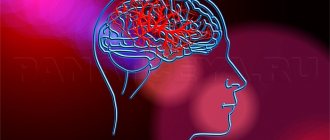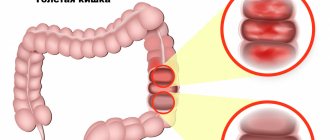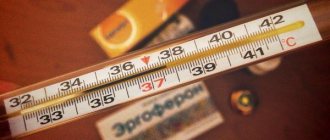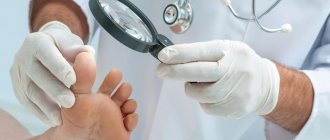What it is
A panic attack is a causeless, debilitating attack of panic or anxiety, accompanied by a feeling of fear and various physiological symptoms.
To understand what a person feels at such moments, imagine the situation. You are walking down the street and suddenly notice that a huge dog is rushing towards you at a frantic pace. There is an ominous grin on his face, his gums are exposed and his sharp, huge fangs are visible. Drool splashes in all directions, and rage and malice are visible in his eyes. How do you feel?
Of course, you will experience incredible fear, you will feel that your heart has stopped, your legs have become weak, and sweat has appeared on your forehead. People experiencing a panic attack feel about the same thing. But there is a colossal difference between you and them: in your case there is a real threat to life, while for them there is no objective danger. That is, their fears are not supported by anything.
However, this is only at first glance; such individuals can say that the attack began suddenly. In further conversation with them, it turns out that panic was preceded by traveling in an elevator or public transport, being in a place with a large crowd of people or on an airplane, or other similar reasons.
The concept of “panic” originates from the name of the god Pan, the lord of fields, forests and herds. According to legends, he suddenly appeared before a person covered in fur and with goat legs, plunging the latter into uncontrollable fear. The man started to run, not knowing where, along the edge of a cliff, not realizing that flight could also threaten death.
In the literature one can find the concepts of vegetative or sympathoadrenal crisis, cardioneurosis. They are identical to the term “panic attack.”
Prerequisites and causes of panic attacks
There are several factors that can become prerequisites for the occurrence of such a condition.
- Genetic predisposition.
If the patient's close relatives suffered from uncontrollable attacks of anxiety and fear, there is a high probability that this disorder will manifest itself in adulthood.
- Severe stress.
Chronic nervous tension, constant quarrels and conflicts in the family or at work, divorce or the loss of a close relative lead to the emergence of inexplicable fear. This feeling is irrational, the patient often cannot explain why he experiences it, he has no objective reasons to be afraid.
- Thyroid gland dysfunction.
This organ is responsible for producing hormones that affect the condition of the body. Increased or decreased production of these substances provokes the occurrence of symptoms characteristic of panic attacks. Perhaps this is autonomic dysfunction that will not develop into paroxysm; in any case, a thorough examination is necessary.
- Low self-esteem.
If a person is guided by the opinions of strangers, is afraid of disgracing himself in society, is a suspicious person, he belongs to the risk group.
- Uncontrolled use of medications.
Often, in order to normalize their condition, patients use various medications - sedatives, sedatives, and blood pressure lowerers. The availability of such drugs and the lack of need for a prescription leads to the constant use of questionable self-prescribed drugs. If a certain dose does not help, the patient increases it, thereby harming his body. Negative consequences include exhaustion of the nervous system and frequent disruptions in its functioning. Also, mental disorders are a consequence of regular consumption of large volumes of energy drinks or drinks that contain a high percentage of caffeine - black tea, natural coffee.
- Alcohol.
Chronic addiction disrupts the functioning of the entire body, primarily affecting the nervous system. In the morning after drinking a large dose of alcohol, a feeling of irrational fear may arise. It often accompanies asthenic syndrome, in which all the patient’s thoughts are only about the next portion of alcohol. Panic attacks caused by alcoholism do not go away on their own; only qualified medical help will help you get rid of paroxysms and overcome addiction.
- Sleep disturbances.
If a person is awake at night and constantly lacks sleep, this depletes the nervous system. It begins to malfunction and gives incorrect commands to the body, which are expressed in fear and anxiety for no reason. Experts recommend sleeping at night; the daily sleep requirement is at least 8 hours. Daytime sleep for 1-2 hours is allowed; it is important during the period of recovery of the body.
- Phobias.
These are mental disorders in which a person is afraid of something specific. This could be a fear of heights, enclosed spaces, or places with large crowds of people. It is impossible to get rid of them on your own; you need the help of a psychologist or psychotherapist; in advanced conditions, you need to consult a psychiatrist.
Also among the possible causes of panic attacks are mental disorders; in this case, PA develops as a secondary disorder. For such conditions, a specific treatment regimen is selected.
If you do not consult a doctor in a timely manner, the intensity of symptoms increases with each new attack. As a result, a person strives for social isolation; the only true way out for him is the decision to stay at home and not go out. Our doctors will teach the patient to cope with attacks, he will be able to fully prepare for the onset of a panic attack, and will not be afraid of embarrassing himself in front of others.
Why does a panic attack happen?
The reasons for this condition have not been fully elucidated. There are many prerequisites and provoking factors that can theoretically cause such a hypertrophied feeling of anxiety.
They are divided into biological, psychological and physiological.
Biological reasons include:
- hormonal changes during puberty, menopause, childbirth;
- beginning of sexual life;
- menstrual irregularities;
- heredity.
Panic attacks develop against the background of certain disorders:
- pheochromocytoma – hormonal tumor;
- psychosomatic disorders;
- phobias;
- depression;
- post-traumatic stress disorder;
- endocrine diseases;
- heart pathologies.
Among the psychological precursors of the condition are:
- acute stress - death of a loved one, divorce, any negative sudden situation;
- identification or opposition of oneself to any subject - the hero of a film, book, etc.;
- isolation from society;
- character traits;
- childhood experience.
As for character traits, most often panic attacks accompany women with a hysterical, demonstrative personality type. They constantly attract attention and crave recognition. Such women often have an extravagant appearance, are pretentious and very expressive. If they notice that they are not of interest to the “victim,” they very quickly switch to another object.
Men suffering from this disease exhibit traits called “health hypochondria.” They care very much about their appearance and strive to always look perfect.
Stress experienced in childhood also contributes to the development of attacks of fear already at a conscious age. One of the common causes is alcoholism in the family, which provokes situations of aggression. It could be a fight, a risk of murder. The situation becomes so acute that they have to flee home, often at night. In this case, fear is fixed, and in adulthood, in similar situations, it is repeated in such an impartial manner, intensified several times.
Another example is families where children grow up in conditions of emotional poverty and coldness. When parents or a parent (if we are talking about a single-parent family) are so passionate about themselves and their work that they simply don’t get around to the child. Or in the case when someone close to you suffers from a serious illness, everything revolves around the sick person, and they simply forget about the child.
Emotional coldness towards a child is present where too great demands are placed on him. At the same time, parents can keep the child under super control, but, at the same time, not show warmth and kindness towards him. Adults raised in such circumstances constantly seek approval and emotional support. Their stress resistance is significantly reduced.
The third model of family behavior is the opposite of the previous one and is based on overprotection of the child. At the same time, his parents are constantly worried about his condition, regarding any situation as potentially dangerous. They control literally all areas of their “blood” and try to accompany him everywhere. By doing this, they support the child’s infantilism, which leads to difficulties in social adaptation.
Constant conflicts in the family develop emotional lability in the child. The inability to influence the situation provokes confidence in one’s helplessness.
Any of the listed models lead to the fact that such a child grows into an adult who is emotionally unstable, insecure, and has difficulty interacting with society. This reduces his resistance to stress, exposing him to all sorts of mental disorders.
In addition to family conflicts, violence experienced in childhood, sexual or physical, contributes to the development of panic attack syndrome.
Physiological factors that provoke an attack include abuse of alcoholic beverages and psychostimulants, physical fatigue, weather changes, and excess solar radiation.
The incredibly talented actor Johnny Depp suffers from panic attacks. According to him, since childhood he has experienced anxiety in any non-standard situation. And the choice of his eccentric roles is nothing more than an attempt to hide his essence in front of millions of viewers.
Treatment of panic attacks in women and men
Treatment of panic disorders usually requires the help of specialists in two fields: a neurologist and a psychologist or psychotherapist. This is due to the fact that complex therapy, including medication and psychotherapeutic treatment, is most effective. The use of only psychotherapeutic methods can be recommended exclusively for mild attacks occurring with a moderate level of anxiety. But drug treatment is basic. Since panic disorders dramatically increase the likelihood of suicidal behavior, refusal of drug therapy can lead to tragic consequences. Therefore, today an integrated approach is used to treat panic attacks in men and women, including psychotherapy and drug correction.
To control the patient’s condition and reduce the risk of developing repeated anxiety attacks, various drugs are used, the choice of which is carried out on an individual basis. These include:
- tricyclic antidepressants;
- MAO inhibitors;
- serotonin reuptake inhibitors;
- β-blockers;
- combination antidepressants;
- nootropics.
Sometimes anxiolytics or tranquilizers are prescribed, both to relieve panic attacks directly and for long-term use to eliminate the likelihood of developing new episodes.
As for psychotherapy, it should never be neglected in the treatment of panic disorders. It is no less important than drug treatment, and in the same way is selected strictly individually by the attending physician based on the medical history and characteristics of the patient.
As part of psychotherapy, people suffering from panic attacks may be offered:
- cognitive behavioral therapy;
- psychoanalysis;
- hypnosis;
- systemic family psychotherapy;
- NLP;
- Gestalt therapy;
- body-oriented psychotherapy.
You should not be afraid of psychotherapy and consider working with a psychologist or psychiatrist to be unimportant or beneath your dignity. It is an important element in the fight against panic attacks and helps reduce anxiety, overcome the effects of stress, chronic fatigue, internal conflicts and get rid of accumulated grievances.
Cognitive behavioral therapy is the type of psychotherapy used most often to treat panic disorders. It includes a number of successive stages with the goal of making the necessary adjustments to the patient’s thinking and attitude towards anxiety. Initially, the doctor will explain the pattern of development of a panic attack and help the patient understand how it occurs and what mechanisms are involved. This will help you get your anxiety under control and get rid of the fear of going crazy or dying during a panic attack from a heart attack or other cause.
Cognitive behavioral psychotherapy involves:
- keeping a self-observation diary;
- meditation practice;
- application of muscle relaxation techniques;
- use of breathing practices;
- detection of factors leading to increased anxiety and carrying out work to eliminate them.
The course of treatment usually consists of 8-20 sessions.
Other methods, in particular psychoanalysis, are used much less frequently in the fight against panic disorders. It is mainly used in the development of anxiety due to the action of specific traumatic factors. At the same time, hypnosis, as a method of treating panic attacks, can give good results in the short term, but it is not suitable for all patients.
It is imperative to minimize the amount of stimulants, i.e. give up or at least significantly reduce the amount of coffee, tea consumed daily, quit smoking, etc.
Tricyclic antidepressants
These are one of the first antidepressants to appear on the pharmaceutical market. They are indicated for patients who have suicidal thoughts, but cannot be used in severe cardiovascular disorders and in elderly patients.
When choosing drugs from this group, it is important to strictly follow the doses recommended by the doctor and increase them to the optimal dose in strict accordance with the developed regimen. In this case, after 2-3 weeks, tricyclic antidepressants will give the expected therapeutic effect and will lead to the complete elimination of panic attacks no later than 4 weeks after the start of treatment.
Their cancellation is also carried out only as prescribed by the attending physician, but even in this case it is important not to immediately stop taking the drug, but to gradually reduce the dose according to an individually designed regimen. However, you need to be prepared for the fact that the process of stopping tricyclic antidepressants may take about a month.
MAO inhibitors
Drugs of this pharmacological group are used for the treatment of panic attacks less often than tricyclic antidepressants, since they more often cause the development of unwanted side effects. Nevertheless, it is MAO inhibitors (monoamine oxidase) that are used for panic attacks that occur with a predominance of autonomic disorders, as well as when tricyclic antidepressants are ineffective.
The choice of a specific drug and dosage is carried out strictly individually. In this case, a minimum dose is initially prescribed, which is gradually increased under the supervision of a physician until the optimal dose is reached. During this period, patients may notice an increase in the level of excitability and become nervous. This is not considered a reason to discontinue the drug and goes away on its own when the main dose of the drug is reached.
It is important not to take MAO inhibitors and tricyclic antidepressants, drugs that increase serotonin levels, and some other drugs at the same time. Their combinations can cause the development of a hypertensive crisis with a sharp increase in blood pressure. Therefore, if it is necessary to change tricyclic antidepressants to MAO inhibitors or undergo another course of treatment, you need to agree with your doctor about this possibility and take a break from treatment for 2-3 weeks.
MAO inhibitors do not combine well with many drugs, in particular PDE-5 inhibitors (Viagra, Cialis, Levitra and their analogues), used by men to combat erectile dysfunction.
Also, for the same reason, you cannot combine the use of MAO inhibitors with products containing tyramine. This:
- all types of cheeses and cheese products;
- any smoked meats;
- marinated, dried fish;
- all types of legumes;
- sauerkraut;
- alcoholic drinks, especially beer, wine and whiskey.
Serotonin reuptake inhibitors
Drugs in this group, also abbreviated as SSRIs, are among the most modern types of antidepressants, and their choice is quite extensive. Their advantages are high efficiency in the fight against panic disorders and a significantly lower risk of side effects. At the same time, SSRIs can be used to control panic attacks in patients with heart pathologies, bronchial asthma and other disorders. And their main disadvantage is considered to be the occurrence of increased excitability, increased nervousness, and anxiety in the first time after the start of treatment. Also at this time, insomnia and a sharp change in mood to the radically opposite may be observed. In this regard, drugs in this group are rarely prescribed to adolescents.
In the same way as when prescribing tricyclic antidepressants or MAO inhibitors, the required dose of SSRIs is achieved gradually, starting with small dosages. The effect of treatment can be assessed after 1-2 weeks.
β-blockers
Drugs in this group are used in the presence of disturbances in the functioning of the cardiovascular system. They help normalize blood pressure and reduce heart rate. At the same time, which is important in the treatment of panic disorders, β-blockers neutralize the effect of catecholamines, which include adrenaline. Therefore, with their help it is possible to eliminate the main manifestations of panic attacks.
Nootropics
Nootropics are used exclusively as an adjunct to antidepressants or other anti-anxiety medications. Their main properties are to improve the functioning of the brain, activate cerebral circulation and increase the intensity of metabolic processes in the nervous structures. At the same time, nootropics help to increase the level of stress resistance, which has a beneficial effect on the well-being of patients with anxiety disorders. But when taking them, their stimulating effect on the nervous system should be taken into account. Therefore, you should not take nootropics at night; it is better to do it in the first half of the day.
Thus, panic attacks are quite common. And although they do not pose a serious threat to a person’s life and health, such attacks of anxiety and outright panic significantly reduce the quality of life and can cause the development of serious mental disorders, including suicidal ones. Therefore, it is important not to ignore the problem or try to deal with it on your own. A much better result will be obtained by contacting a neurologist and psychotherapist. These specialists will help eliminate the causes of panic attacks as quickly as possible and teach a person to control their emotions, increase the level of stress resistance and, in general, achieve the disappearance of attacks of unreasonable panic.
4 1 vote
Article rating
Signs of the syndrome
A panic attack usually develops suddenly. And he can find the patient anywhere, at any time of the day. Its manifestations vary: from an uncontrollable, painful feeling of fear and anxiety to internal discomfort. A panic attack with mild symptoms is called “panic without panic.” In this case, physiological symptoms dominate.
The duration of the attack may be only a few minutes, in other cases it lasts several hours. But on average its duration is 20–30 minutes. PAs are repeated in one situation 1–2 times a day, in others – several times a month. Having experienced such sensations for the first time, a person retains the memory of them for the rest of his life.
There is an incredible accident when a patient experiences attacks only a couple of times in his entire life. They disappear without a trace, presumably after the stress factor ends.
A panic attack is accompanied by the following symptoms:
| Psychological | Physiological (vegetative) |
|
|
The first case of a panic attack is expressed by an extremely strong fear of dying. Its power is so powerful that it can drive the patient into a state of passion. In subsequent cases, the feeling of imminent death is transformed into a specific phobia. This could be a fear of going crazy, suffocating, etc.
There are situations when the condition is not accompanied by an anxiety-phobic complex. Emotional symptoms come to the fore: apathy, a feeling of uselessness, aggression, nervousness.
After a paroxysm, patients feel exhausted and overwhelmed.
Panic attacks most often occur between the ages of 25 and 50. Approximately 5% of humanity suffers from the pathology. And what’s interesting is that they are mostly residents of large cities. In old age, such paroxysms occur rarely, have an erased character and become remnants of attacks that occurred in youth.
Those who have experienced a similar condition at least once in their lives describe it with horror and excitement.
For example, a girl had an attack while she was driving in a car with her husband and child. There was a feeling of lack of air, an unreal horror ran through from head to toe. In an instant there was a desire to open the door and jump out of the salon. The busy highway held me back.
Another patient was seized with fear when certain sounds appeared. I felt a nasty tingling sensation in my palms. Excitement sets in, causing your thoughts to become confused and your tongue to be taken away.
A woman described her husband experiencing a panic attack while they were walking in the park and talking about a relative who had recently had a heart attack. She noticed that her husband's arms and shoulders suddenly began to shake. He was covered in sweat, it was even dripping. His face turned pale, he practically stopped breathing (he couldn’t take a breath), his gaze was wandering and unconscious. The man was sure he was dying. It took almost 2 hours to get home, whereas it usually took 20 minutes. He constantly stopped, sat down on the ground, and the attack repeated.
Development mechanism
No one can reliably explain the pathogenesis of a panic attack. But there is a theory according to which the trigger is negative thoughts when they accidentally visit a person. Their action, akin to an objective threat, provokes the release of adrenaline and similar substances. They constrict blood vessels, causing increased heart rate and breathing. Blood pressure increases, and even in those who, in principle, do not suffer from this, the indicators reach 200 mm Hg. Art.
The amount of carbon dioxide in the blood decreases, and symptoms of hyperventilation, that is, breathing problems, increase. Receptors that cause excitation are stimulated and those responsible for inhibition are blocked. Thus, there is an increase in anxiety and panic symptoms and feelings of fear.
Many patients suffering from this disease are very afraid of losing consciousness. But in a panic crisis this is unlikely. All its development mechanisms indicate the opposite. In this state, the unconditioned “fight or flight” reflex is activated, which accompanies a frightening situation. In addition, high blood pressure and intense heartbeat simply will not allow you to do this.
Fear of fainting causes the patient to experience numbness in the limbs and dizziness. They are what confuse you.
Causes
The mechanism behind the formation of panic attacks is not yet known. There is a theory that an attack is provoked by negative thoughts that provoke the release of adrenaline. The growth of the hormone in the blood leads to increased heart rate, breathing, and increased blood pressure. Adrenaline blocks the receptors responsible for inhibition, and excitement, anxiety, and fears increase. During an attack, a person may be afraid of losing consciousness, which leads to dizziness and numbness of the limbs.
The following reasons can also provoke attacks:
- heart attack;
- cardiac ischemia;
- childbirth, pregnancy;
- menopause;
- an adrenal tumor that interferes with the synthesis of adrenaline;
- thyrotoxic crisis;
- thyroid diseases;
- long-term therapy with hormonal drugs;
- severe stress;
- hereditary history of anxiety or mental disorders.
Provoking factors
In addition to the reasons that directly change the functioning of the autonomic system and the release of adrenaline, norepinephrine, and dopamine, there are also risk factors that increase the likelihood of a panic attack in a healthy person. These include:
- drug and alcohol abuse;
- lack of physical activity – physical inactivity leads to restlessness, impulsiveness and panic attacks;
- smoking;
- chronic lack of sleep;
- constant suppression of emotions.
Night PA
A panic attack can strike a person at any moment, even at night. At night, in silence and in the dark, when the patient has nothing to distract himself with, he concentrates on his thoughts of a varied nature, including negative ones.
Another reason is nightmares. But do not confuse the attack itself with a terrifying dream. Paroxysm develops after a nightmare has been seen. And it cannot be forgotten, unlike a dream.
If we are talking about panic attacks of falling asleep, then they most often occur between 00.00–4.00 in the morning. The attack can also awaken its victim in the middle of sleep.
Nighttime PA significantly undermines human health. He suffers from sleep disorders, usually insomnia or problems falling asleep.
Insufficient rest at night provokes headaches and chronic fatigue during the day. The patient's productive activity decreases. He becomes nervous and irritable. The mood becomes depressive.
The symptoms of night attacks repeat the typical manifestations of the condition and also contribute to the development of phobias. So, after the death of her father, the girl began to have panic attacks. She noted that she experienced respiratory spasms at night. Often the thought appeared that he might not wake up. She even asked her friends to call in the morning to check if she was alive.
If a person, during a paroxysm at night, feels disconnected from reality and does not understand what is happening to him, then this feeling persists during the day. An exhausted nervous system that did not have time to recover overnight does not perceive objective reality. The patient does not understand who he is and what is happening to him.
A panic attack of awakening occurs early in the morning. The patient wakes up from a sudden and overwhelming feeling of anxiety. Gradually, other symptoms join in. Naturally, a person can no longer fall asleep, and he feels exhausted and unrested.
Medication support
A psychiatrist is involved in selecting medications for the treatment of panic attacks. A properly selected medication regimen will quickly reduce the frequency, intensity and number of symptoms of panic attacks. Appointments may include:
- Tranquilizers for quick relief of panic attacks. These drugs can cause addiction, so in no case should you increase the dosage on your own and use them daily, just to prevent attacks. These remedies are first aid for a severe panic attack, nothing more.
- Antidepressants for panic attacks. These drugs are used in serious cases where a panic attack occurs due to depression. This indicates a serious stage of the disease, which may require not only treatment for panic attacks, but also treatment for depression in a hospital.
- Beta blockers. The drugs quickly reduce high blood pressure and tachycardia during panic attacks.
- Nootropics. People suffering from panic attacks often complain of problems with memory and thinking in general. These drugs help improve blood circulation and brain performance.
How to recognize the disease
Panic attacks, given the variety of its somatic symptoms, can masquerade as various organ diseases.
Most often, the patient feels like he is having a heart attack. Discomfort in the heart area is one of the most common phenomena among “alarmists”. They feel pain and tingling in the chest on the left side, palpitations. A pressing feeling appears, the heart seems to stop. But a regular ECG, echocardiography, ultrasound of the heart, 24-hour ECG and blood pressure monitoring can help rule out heart disease.
As for tachycardia, it is indeed present. But the reason for this is the activation of the sympathetic nervous system as a result of stress.
Another common condition that patients suspect is a stroke. Headaches, increased blood pressure, paresthesia in the form of tingling in the limbs, as well as changes in gait confuse him. The person gets very scared and even calls an ambulance.
The unrealistic fear that accompanies a patient with an attack separates him from reality. A person gets lost in space and does not perceive his surroundings. He fears that he will lose control of himself and do something unacceptable. He feels like he's going crazy. Because of this, such patients often fear that they are developing a mental disorder. Although mental problems can indeed appear. They are the result of a disorder.
Increased concern about one's health causes such a patient to develop hypochondria. He constantly visits all kinds of doctors, takes a whole bunch of tests. When specialists try to explain to him that the cause of his bodily discomfort is more psychological than physiological, they become irritated. And they go to another doctor in the hope that he will help them and get to the bottom of it.
Against the background of the disorder, depressive thoughts appear, since the person is really seriously concerned about his condition and does not know how to help himself.
Agoraphobia is a fear of open spaces or a specific place, literally “fear of the market square” can also become a complication of a panic attack. If the patient associates its occurrence with a certain place, then in the future he will avoid visiting it. A person may even be afraid to leave the house so as not to experience this painful feeling again.
Continuous, complicated attacks of PA can develop into panic disorder. To establish a diagnosis, the following criteria must be present:
- several severe attacks occur in a month;
- without a real threat;
- arises not only against the background of a predictable situation;
- non-anxious periods between attacks.
An important symptom of panic disorder is the constant anticipation of the next attack. In addition, the absence of the influence of psychostimulants (drugs, alcohol) is taken into account. Phobias and obsessive-compulsive disorder are excluded.
To confirm that the patient is really experiencing an attack of PA, and is not suffering from some real disease of the internal organs, the doctor is obliged to prescribe a series of examinations:
- ECG, ECG – monitoring; EEG;
- Ultrasound of the heart and other organs;
- radiography;
- CT, MRI;
- stomach examinations;
- blood test: CBC, liver tests, hormones:
- consultation of narrow specialists.
Basic information and theories of origin
A panic attack can last from a few minutes to an hour. But most often it lasts no more than half an hour and goes away as abruptly as it appeared. And although it does not pose a serious threat to physical health, such attacks of severe fear are very exhausting and damage a person’s mental state. In addition, having once suffered such an attack, people are unconsciously afraid of its repetition and are constantly in a state of stress, which further aggravates the situation. In the future, panic attacks can lead to:
- avoiding crowded places and limiting movement;
- fear of being alone;
- fear of being far from home or in a place where it is impossible to quickly receive qualified medical care;
- severe depressive states;
- disturbances in concentration;
- loss of performance.
Today, panic attacks are not uncommon among either women or men. Although women are 5 times more likely to suffer from them than men. According to statistics, about 10-20% of people around the world experience a panic attack at least once in their lives. In other words, almost every fifth person experienced an attack of severe fear at least once. Therefore, many experts already consider panic attacks not even as a disorder, but as a feature of human behavior.
At the same time, about 0.5-1% of people regularly experience panic attacks. But this is an average. It varies greatly depending on a person's region of residence, country, social conditions and other factors. In such situations, they already speak of the presence of pathology, and in 2/3 of all cases, neurological or mental disorders are detected. And 20% of people from this number have alcohol or drug addiction.
Most often, panic attacks are observed in women and men aged 25-45 years. Although they can also occur in older people and adolescents. It has been noted that they are more typical for people with an above average level of intelligence.
Panic attacks can occur on their own or develop against the background of other diseases, not only mental, but also pathologies of the cardiovascular, endocrine system and others. Sigmund Freud once attempted to describe panic attacks by calling them anxiety attacks. Subsequently, they were considered as a manifestation of vegetative-vascular dystonia and were called an emotional-vegetative crisis.
A large amount of work has been done on the study of anxiety states, and only in 1980 the term “panic attack” was introduced, including in ICD-10, to describe the main manifestation of such disorders. But research in this area and anxiety disorders developing against the background of panic attacks is still ongoing. The result of this was the creation of a number of theories of the occurrence of panic attacks, although today many experts are inclined to believe that a panic attack is a consequence of a combination of various factors described in individual theories.
It has been precisely established that the primary source of their development is the physiological processes occurring in the body as a result of stress, namely changes in the functioning of the temporal lobes of the brain and some parts of the limbic system (a set of brain structures located on the sides of the thalamus). As a result of anxious thoughts, adrenaline is released, which aggravates anxiety. This in turn can trigger a panic attack, which increases anxiety. This creates a vicious circle that can be difficult to break.
Catecholamine theory
This hypothesis is based on the possibility of a panic attack occurring against the background of an increase in the level of catecholamines, which include adrenaline. They are produced by the adrenal cortex in response to stress factors. These compounds have stimulant properties, meaning they cause blood vessels to constrict, which leads to increased blood pressure levels, and also stimulate the nervous system and lead to an increase in heart rate.
Genetic theory
This theory is based on the fact that 15-20% of people suffering from panic attacks have relatives with the same anxiety disorders.
Psychoanalytic theory
This hypothesis was developed by S. Freud and has since been refined by other researchers. According to it, panic attacks occur against the background of a lack of emotional, including sexual, release, and the presence of a person’s conflict with himself and his needs. This leads to physical tension. Over time, a conflict or other stressful situation provokes the development of anxiety.
Behavioral theory
This theory is based on the connection between a panic attack and external causes, which can be situations that threaten a person in one way or another. The resulting increase in heart rate is recorded by the body as a trigger. And subsequently, when the pulse rate increases, which may be a symptom of one or another heart pathology, a panic attack develops even in the absence of a threat.
This theory also describes cases of the development of anxiety states in people prone to pessimism. For example, one day, while in transport, a person is struck by the thought that an accident might happen. If it causes fear, a panic attack may develop even against the background of complete well-being and no danger to life. In such cases, a panic attack is not a consequence of a direct threat, but of a far-fetched potential situation.
Cognitive theory
This theory is based on a person’s ability to misinterpret their feelings. Thus, shortness of breath after exercise or increased heart rate may be mistakenly perceived as life-threatening. The result is fear and a panic attack.
help yourself
At the moment when you are overtaken by an attack, it is very difficult to control yourself. But you can try to pull yourself together and help yourself get rid of it quickly:
- Go out into the fresh air or open the windows, unbutton tight clothes. Pour cool water over your face.
- It is important to switch to breathing. Try to breathe deeply, slowly and fully. To increase the level of carbon dioxide in the blood, breathe into a bag or cupped palms (imitate the position of breathing into them, trying to warm them up).
- Try to think about something positive or talk to someone. Try counting to 100 or count passing cars or trees if fear catches you in transport or on the street. All this helps to shift attention away from anxious feelings. If the cause of alarm is a certain place, hurry to leave it.
- To stabilize your body, place your hands on a stable surface or press your feet into the floor. This position will give you a feeling of confidence and control.
- Keep telling yourself that this will all end now. The anxiety that arises will not harm you, it is simply a figment of your imagination.
If you witness an attack on someone, you can help the person cope with the problem. The main thing: do not panic yourself! You must be calm. And with your calmness set an example for him.
Talk to him, hug him on the shoulder or squeeze his hand. Show me how to breathe correctly. If conditions permit, give the person water or warm tea.
The main thing is not to get confused in this situation. Remember, your behavior can significantly alleviate the panicker’s condition.
Panic attacks: how to deal with it yourself
We categorically do not recommend self-medication. Such events aggravate the patient's condition. He cannot independently determine whether he has concomitant mental disorders.
Pharmacology taken uncontrolled can provoke an increase in symptoms and make the patient’s condition more severe. This complicates further therapy in the hospital, increases the time of recovery and complete restoration of the body. The Clinic of Dr. Isaev provides round-the-clock care for patients in serious condition who, due to mental disorders, are unable to care for themselves.








